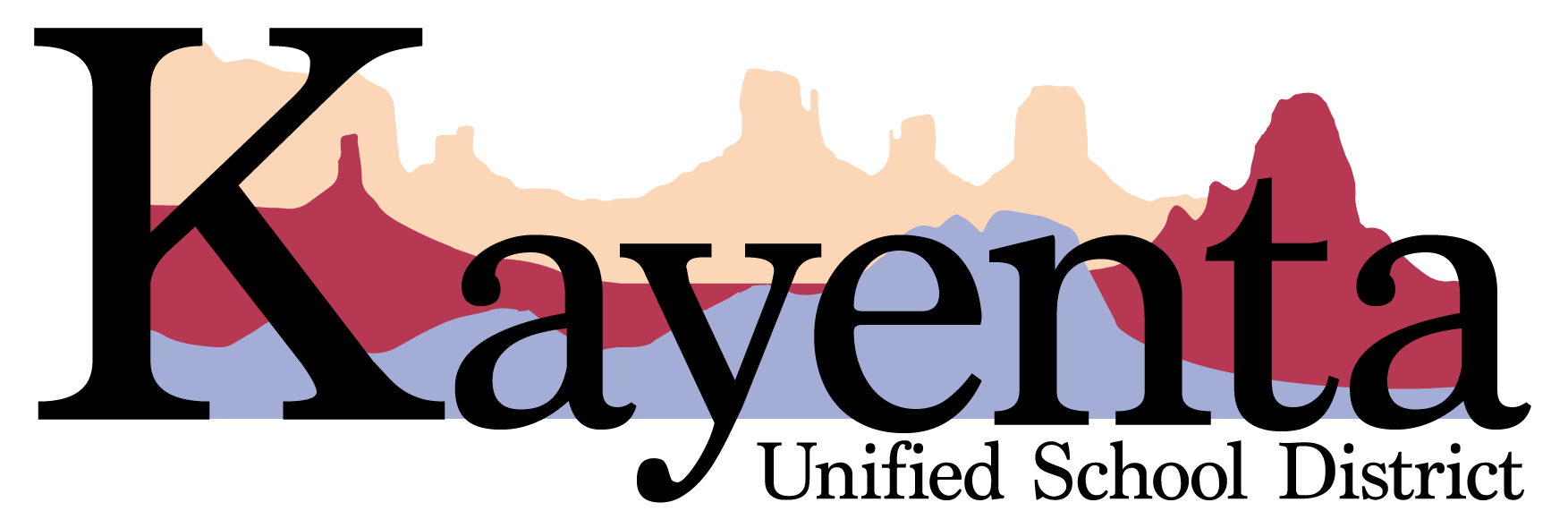


English Learner Program
Kayenta Unified School District’s English Learner Mission Statement
It is the mission of the English Learner (EL) Program at Kayenta Unified School District to provide its students with the knowledge, skills, and confidence to be socially and academically successful in English. This will be accomplished by providing an inclusive program that values the native language and culture of its EL students, provides EL students with the content and necessary background knowledge to meaningfully participate in the curricula, equip EL students with the English language skills that are necessary tools for full participation in the K-12 education setting, and prepare EL students to participate with confidence and an empowered sense of identity, then succeed in post-secondary academic, professional, and personal fields of choice.
Introduction to EL
EL, or ELL, are acronyms that refer to a specific group of students and/or the instructional services schools provide to them. EL means English Learner. ELL means English Language Learner. The services schools provide to the EL, or ELL, group of students are called EL Services.
The intent is to identify students whose English language proficiency prevents them from being able to get the most out of their academic classes. In other words, EL students struggle with the English language, and that struggle is a barrier to their success in their classes. Once EL students are identified, the school will provide academic supports that are intended to help them improve English language proficiency, so they can get more out of their daily classes.
How EL Students are Identified
There are two ways for EL students to be identified. The first consists of the student already being identified as EL and continuing through the program into the next school year. This might look like a student transferring into KUSD from another district where he/she was EL. This might, also, look like a student who was identified EL several years ago, transferred out of state or to a BIE school, and now has a gap in service. Because this student did not exit the EL program with a proficient AZELLA score, he/she is still an EL student. Students will not exit the EL program until they achieve a score of “Proficient” on the AZELLA (Arizona English Language Learner Assessment) state test.
The second way a student can be identified EL is with a Home Language Survey form. When new students enroll in KUSD, part of their enrollment package is the Home Language Survey form. This is also called the PHLOTE form, Primary Home Language Other Than English. This survey asks three specific questions about the language(s) spoken by the student and in the student’s home.
What language do people speak in the home most of the time?
What language does the student speak most of the time?
What language did the student first speak or understand?
When a PHLOTE form has an answer to one of the three questions that is a language other than English, the Arizona Department of Education (ADE) requires schools to AZELLA Placement Test the student within the first 30 school days, if the form was submitted at the start of school year. Or, within 10 school days if the PHLOTE form was submitted after the school year started, ARS 15-756 (B). If the AZELLA Placement test results show the student is less than proficient, the student is automatically identified EL and will receive language supports from the school. If the test shows the student is proficient, the student is not identified EL, is not entered into the EL program, and is not eligible for language supports and services.
Two AZELLA Tests, Placement & Reassessment
There are two Arizona English Language Learner Assessments (AZELLA) tests. The first is the AZELLA Placement test. The second is the AZELLA Reassessment test. The Placement test is usually administered in the fall but can be administered anytime a new student enrolls in the district, if applicable. The AZELLA Placement test will identify the student’s English language proficiency. If the Placement test score indicates the student is proficient in English, the student is not entered into the EL program. However, if the Placement test results show the student is not English proficient, ADE will use that score to enter, or “place”, the student into the EL program. Once identified EL, the student will receive academic supports related to English language development and will take another AZELLA test, the Reassessment test, during the spring semester.
The AZELLA Reassessment test will give the student the opportunity to demonstrate English language proficiency after receiving the instruction and supports associated with the Placement test’s EL identification. When the student scores “proficient” on the AZELLA Reassessment Test, the student exits the EL program, because the demonstrated need for academic language services is no longer evident. The student was “reassessed” and showed English language proficiency; therefore, the student’s status changes from EL to ‘Reclassified Fluent English Proficient (RFEP)’. This is what is meant by “AZELLA into the EL program and AZELLA out of the program.” The only way into the EL program is with an AZELLA score that shows a language need and the only way to exit the program is with another AZELLA score that shows the language need no longer exists.
Parent Notification and Consent
After a student tests into the EL program, a Notification/Consent form is completed and given to the parent, or guardian, for signature. By signing, parents and guardians show they understand the EL identification based on the AZELLA test results and give the school consent to provide the services intended to improve the student’s language proficiency.
By signing the Parent Notification and Consent form, parents/guardians are giving the school permission, or “consent”, to address their student’s documented language needs. If parents/guardians do not consent to the schools providing the EL identified students with language instruction, they can opt out of receiving the language services.
Parent Withdrawal
If parents/guardians would like to opt out of EL instruction and services, they will need to meet with the school’s principal and the district EL Coordinator to sign a Withdrawal from services form. Before parents/guardians can withdraw from the EL instruction, they must first sign the Parent Notification and Consent form. Signing the Notification form means the district “notified” the parents/guardians the AZELLA Placement scores entered the student into the EL program and show the student has a need for additional English language instruction. It is important to note that the withdraw only opts the student out of the instruction. The student will still be identified EL and will continue to take the AZELLA Reassessment test every spring semester, even if withdrawn from services.
The Withdrawal form meeting will need to be scheduled in advance. Withdrawing from the EL classes and instruction removes the student from the language services the school is required by statute to provide. Withdrawing from services makes testing proficient more difficult, because the student tests without having had access to the instruction designed to help the student exit the program. Students are not exited from the EL program until they AZELLA test proficient. Withdrawal forms only withdraw students from the services needed to score well on the AZELLA Reassessment Test. They do not remove, or “withdraw” students from the EL Program. ADE requires all EL students to take the AZELLA Reassessment test each spring semester, whether they are withdrawn from the language services, or not. Students who receive the services go into the Reassessment Test with advantages students who withdraw from the services do not have.
EL Services
The Arizona State Board of Education identified four research based Structured English Immersion (SEI) models school districts can choose from to meet their EL students’ instructional needs. KUSD chose the Pull-Out model.
Using the Pull-Out model to provide language services and instruction means:
English language instruction is provided to EL students in two ways. The first component comes during a Targeted SEI class. These are small classes with only EL students. These classes should have students from the same grade level, and to the extent possible, students in these classes should be grouped by proficiency level. English language will be the primary focus. Teachers will choose from 10 different English Language Proficiency Standards (ELPS) to help EL students improve writing, reading, speaking, and listening skills. This class will benefit EL students in their core classes, because the Targeted teacher will collaborate with math, science, social studies and English teachers. The Targeted teacher will use the same resources and materials in the language class that the core teachers use to teach their subjects. Exposure to the same resources and materials in two different classes will allow the students to reach deeper levels of understanding the content and that will lead to better grades in core classes.
The second component of the Pull-Out model of instruction is Integrated teaching. This instruction will occur in regular English and/or core classes, like science, social studies, and math. EL students will receive Integrated Instruction with Non-EL students. Emphasis is on integrated instruction. Here, also, teachers will use what they are already teaching in their class to improve a student’s specific language need. The idea is for a core teacher to teach the class to all of the students in the class and to use English Language Proficiency Standards to scaffold instruction for English Learners. It's a way to help English Learners get instruction that is more relevant to them and that helps them improve upon their academic language proficiency.
The Pull-Out model looks like EL students receiving integrated instruction while in their regularly scheduled math, science, social studies or English class. And, taking a Targeted class for English Language Development. This Targeted class should be taken instead of an intervention class—but should be helpful because the teacher will rely heavily on math and reading to teach English language and improve the student’s reading, writing, listening and speaking.
Put differently, Targeted Instruction will use the ELPS to teach English language to small groups of EL students using the same materials core teachers use in their classes. Integrated Instruction relies on content standards, in core classes, to drive instruction for all students in the class. However, it will also develop language at the same time but with a slightly lesser focus because in the core class the priority will be on the core subject taught.
For EL related questions, or to schedule a Parent Withdrawal from Services appointment, please contact your student's School Principal.
Parent & Guardian Family Engagement
The EL Program hosts approx. five engagement nights per school year. The intent of these engagements is to share with families what kind of services and instruction their students receive at school, discuss AZELLA data, and identify tips for practicing language proficiency strategies at home.
The engagement nights provide an opportunity to bring elementary, middle school and high school teachers together to share how they make their classroom instruction more relevant for their English Learners. In addition to bringing teachers together to share what their classroom teaching strategies look like for their ELs, engagement nights give teachers an opportunity to share tips and strategies families can work on at home to practice academic language development. Finally, engagement nights give the EL Program a chance to build community with families we serve and share more about the program and where its going based on current and previous data, data trends and keep families current with program developments.
There are scheduled EL Family Engagement nights: Each is scheduled to take place from 5:00pm-7:00pm.
SCHEDULE IS CURRENTLY PENDING - please check again
Families who could not attend an engagement are encouraged to access video of what took place. The content of each engagement night can be accessed using the QR Code to the left. Please view and see what you missed. We hope to see you at the next one.
Engagements take place at different school sites, but are always open to all of our EL parents and guardians. They usually consist of three presenters--two teachers, each from a different school and a district speaker who will address data or a district wide EL development. All EL parents and guardians are welcome at each Family Engagement night regardless of where it takes place.
